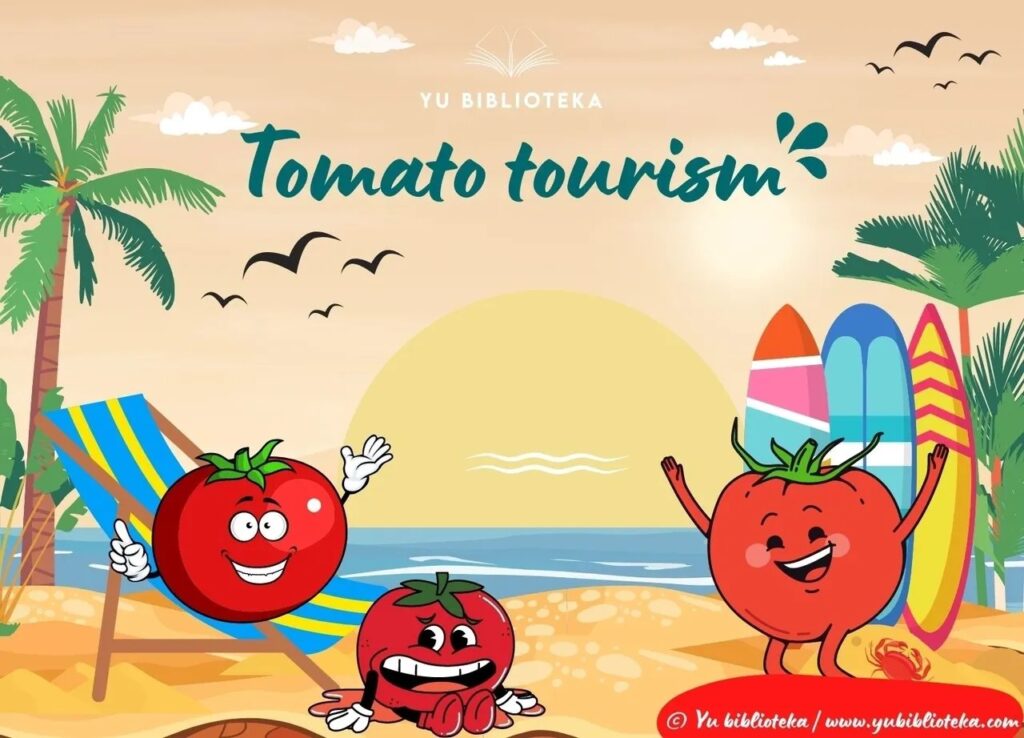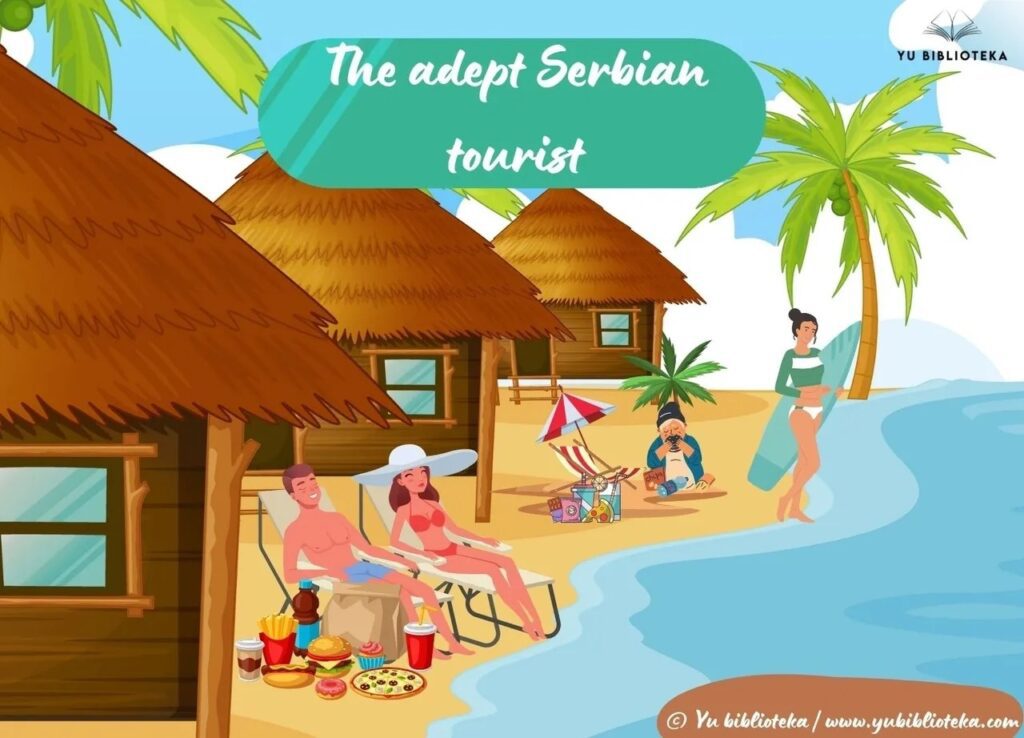The Legend of Tomato Tourist

How do Serbian people vacation
The long-awaited summer is here. The season of taking well-deserved days off from work has begun across the northern hemisphere.
People in the Balkans do summer differently. Hot, humid days smell differently here, intoxicated by the scent of watermelons, chlorine and sweat in the air.
Our summers are hot and sunny. Occasionally, hot air masses from Africa reach Europe, and Serbia is among the first ones there to feel that kick of humidity and oppression when the temperature climbs over 40 degrees Celsius (104F).
That’s why we thought of elaborate ways of making the hottest days bearable. Most of those include travelling to the seaside – sadly, Serbia no longer has one – visiting popular European spots, or even kicking back in the comfort of our own homes, gardens, and the countryside.
Whatever Serbs do, they do it with style.
Favorite summer holiday practices
Serbian people are extremely fond of their summer holiday. Core memories are being made during summer. It’s what they work for during the rest of the year, saving up and paying for exotic destinations several months upfront.
The usual suspects on the list of favorite destinations are Montenegro, Greece and Turkey. Around 900,000 Serbs choose Greece each year. An occasional Croatian marine town pops up here and there, some venture further away across the Adriatic Sea, while others choose the luxury and all-inclusive experience in the majestic hotels of Egypt.

Depending on the budget, the usual amount of time one spends vacationing is 10 days, sometimes 7. There once was a time when a Serbian/Yugoslavian family would spend more than two weeks at the seaside, but nowadays they’re lucky to book and pay for ten coveted days to get tanned and crispy while reading a book in the shade or chasing after mischievous toddlers.
With the latest surge in prices everywhere, it is getting more difficult to imagine a glamorous, all-inclussive ten-day vacay. However, Serbian country has been in an unstable financial recession since the early 1990s, so if there’s anything we’re good at it’s finding ways to secure a cheap, unforgettable vacation. The gas might be extravagantly costly, and we might not have a sea connected to our borders, but there are plenty of local lakes and rivers to dip our toes in.
However, ten days might not be enough for swimming and dipping toes in any body of water, so what most Serbs resort to is one of the two glorious options – going to the community pools, or enjoying your own itsy-bitsy DIY inflatable pool in the garden.
If you’re childless it’s understandable why the second option makes you cringe. But trust me, there’s no shame in soaking in the kiddie pool in the backyard.

Tomato tourism
In case you have been living under a rock and have no clue about the mentality of the Serbian people, let me tell you an outrageous tale about the distorted image of the Serbian tourist that, sadly, is as true as outrageous tales go.
Back in the 80’s, when Serbia was part of a greater good called Yugoslavia – and indeed had a long coast attached to its southwest borders – the Serbian tourists in Greece landed a cute, quite noble nickname – the tomato tourists.
Greece was the rave even then, when Yugoslavian families became intrigued by this new, exotic country, and would spend glorious weeks at the seaside – yes, weeks, as having only ten days to vacay was considered downright broke – dipping their toes in both seas that encircle the magical Greece. With the door to the Greek ajar, the Serbian tourists rushed primarily to shop rather than swim and tan.
Except for the kids. The kids always want to swim.
Since most of the budget was thus wasted on shopping for items unavailable in Serbia, the tourists resorted to homecooked meals. Restaurants were pricey, and the food at the markets cheap. It was a custom to buy groceries and meat, and cook entire meals in the hotels/apartments.
You know how you hate leaving your things unattanded at the beach while you go for lunch? Or even worse, bringing all of your things – towels, clothes, sun creams, sand toys, balls, inflatable floating thingies that your kids won’t go in the water without – with you and returning them all to the beach after lunch?
If you were as resourceful as a Serb, you’d bring your homecooked lunch to the beach, eat it out of plates with proper utensils, and cut the most delicious, cheap Greek tomatoes right there, in the sandy essence of Greece.
Thus, the tomato tourism was born.
It must have been quite a sight, to be lying in the shade, sipping cocktails, and watching the whole family as they munch on tomatoes with sand on their fingers and salt in their sun-kissed hair.
However, this was just the beginning of the tomato tourist reputation that soon took a nightmarish turn. Just ask any Greek travel agency and apartment owners.
When you book accommodation you pay a fixed price per night or per stay. That might or might not include meals, but it certainly includes the usual amenities like electricity and water.
What Serbian housewives have thought of – probably backed by their equally brilliant husbands – is to use all the amenities to their advantage. And by all, I mean literally all. Tomato tourists are now people who buy affordable vegetables and ingredients and make things like ajvar, roasted red peppers, and sour cabbage while on a vacation in Greece.
The absurdity of it is exceeded only by its brilliant practicality. I honestly do not know anyone who has made ajvar in Greece, but that’s exactly the point – they will never reveal themselves. They hide in the shadows and make up stories of how wonderful their stay in Greece was, how absolutely delightful it was to swim, when in fact they were holed up in their accommodation, grinding peppers and mixing batches of ajvar over the stove.
I have heard stories from people who know people who heard from bus drivers about tourists who come back to Serbia with two gigantic suitcases, heavy as the earth itself.

The adept Serbian tourist
No one can exactly pinpoint a moment in time when this clever plan was thought of, but it must have happened sometime in the last decade. As I’ve said before, Greek travel agencies, owners of private apartments and hostels, even bus drivers are appalled by this uniquely Serbian practice. To be fair, this usually occurs in September, when the sea is warmer and the season for making all kinds of Serbian canned food is ripe.
Before you think of us as barbarians and brutes, let me kindly remind you that all this is done in efforts to save up. Pricey days are ahead of us. I’d like to see other countries coming up with such ways of reducing the cost on, well, almost everything. We just need to figure out how to obtain gasoline without selling our kidneys.
There is another group of tourists that fall under the tomato category. They do not wish to taste delicacies from countries they visit. They do not wish to eat out in restaurants, or perhaps they would if they could afford it. This subcategory relies on bringing the entirety of ten-days worth of meals for the whole family – snacks included – with them to Greece, Montenegro or Croatia.
They pack salamis, bacon, pates, sardines, soups, pasta, rice, frozen meat and side dishes. They bring two to three mini fridges into the car – that’s why the location is crucial, you can’t really pack mini fridges to Egypt or Turkey – pack-full with food, sodas, sandwiches for the road.
They are not ashamed to eat sardines and hotdogs they brought from home in the middle of the beach. Because vacationing is often not about the food, or the comfort. It’s about not doing anything for the duration of ten glorious days except lying on the sand, tanning, swimming and making a sand castle.
